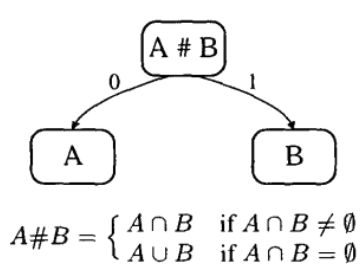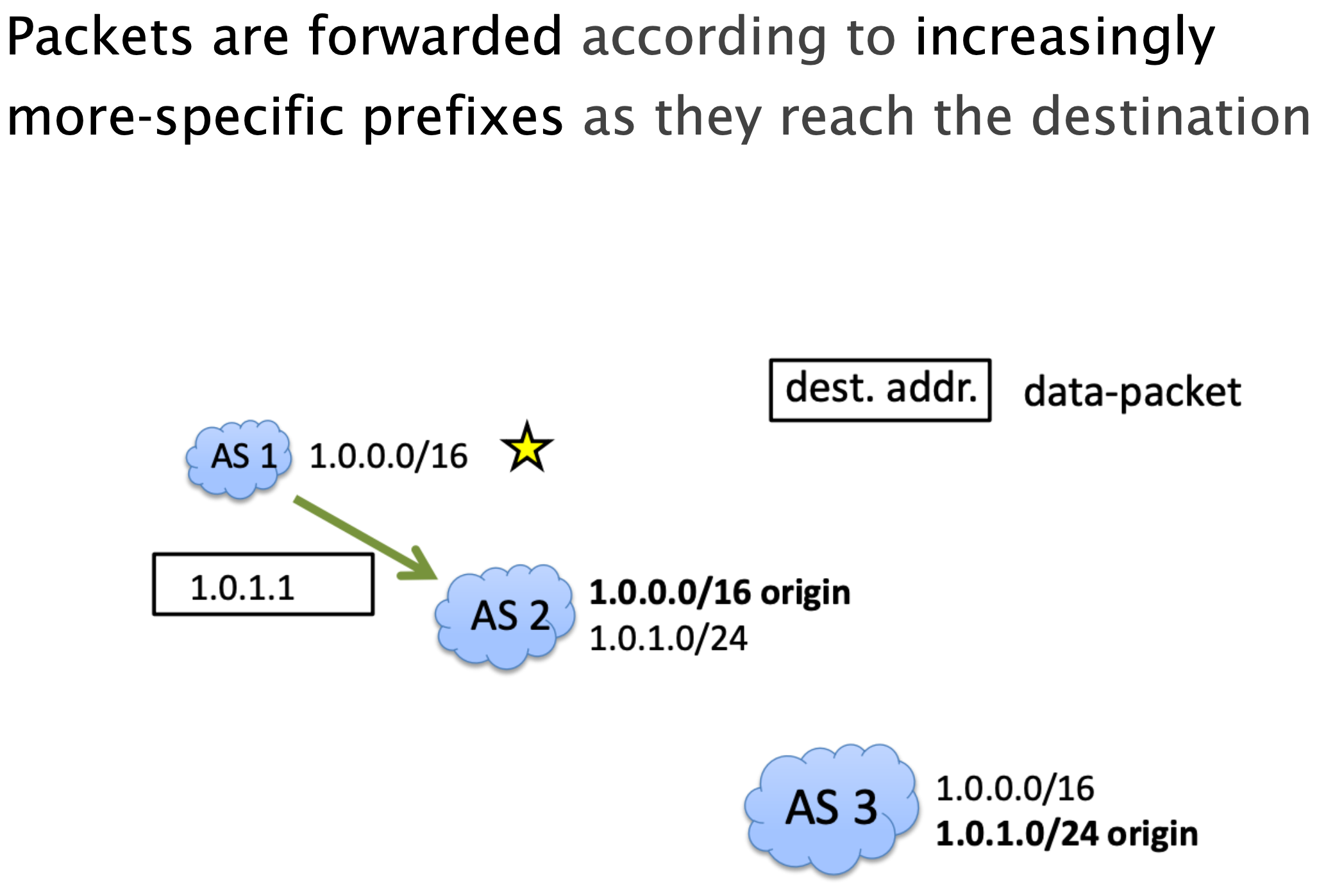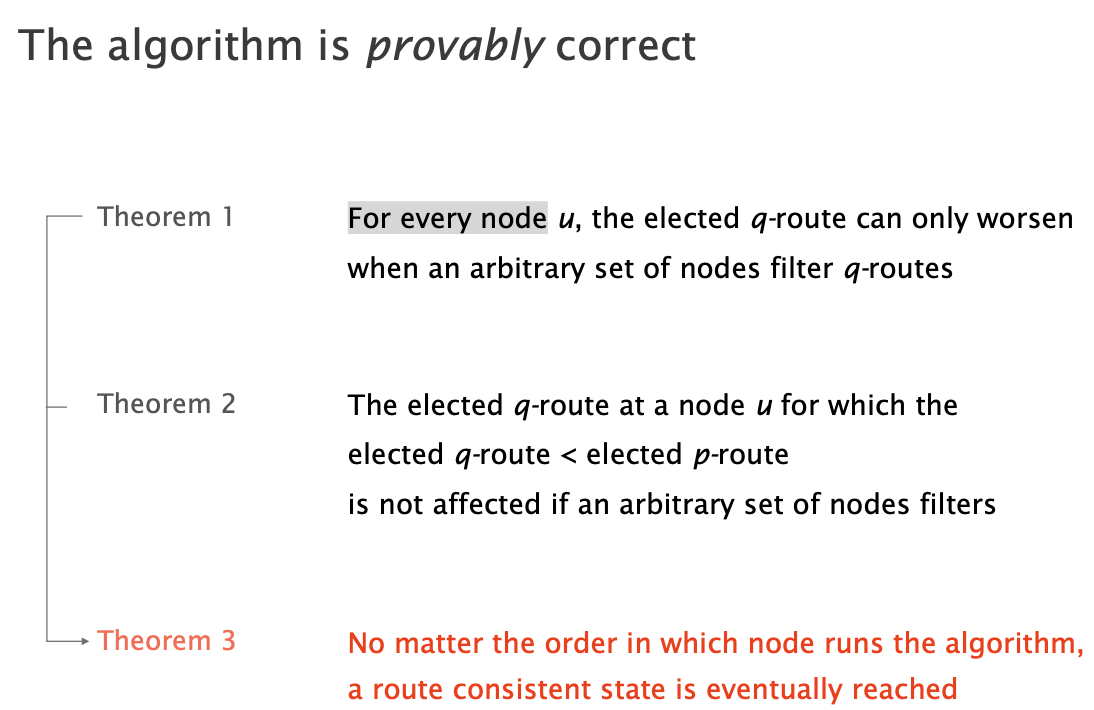Prefix filtering and aggregation
Prefix aggregation and filtering
Maintaining many forwarding entries is problematic for at least 3 reasons:
| Resource | Issue |
|---|---|
| bandwidth | Installing many entries in a linecard is slow |
| memory | Routers linecards have limited (and expensive!) memory banks to hold these entries |
| processing power | It is time-consuming to compute one forwarding entry per destination |
The key idea behind prefix aggregation/filtering is to leverage the IP addresses hierarchy. A child prefix can be filtered whenever it shares the same output interface as its parent.
We can apply prefix aggregation/filtering either:
- locally, at the FIB-level, targeting only one FIB
- router-level gain
- short term
- or globally, at the RIB-level
- network-level gain
- long term
One can identify up to 4 local aggregation/filtering strategies.
Strong forwarding consistency
The first 2 strategies are simple and preserve strong forwarding consistency.
Strong forwarding consistency mandates identical forwarding behaviour for all packets. The longest-prefix lookup of any destination that appears in the original FIB should return the same next-hop before and after aggregation.
Any non-routable destination by the original FIB should not be routable after aggregation.
- Packets that were dropped initially will also be dropped after aggregation
Weak forwarding consistency
Weak forwarding consistency mandates identical forwarding behaviour only for routable packets. The longest-prefix lookup of any destination that appears in the original FIB should return the same next-hop before and after aggregation.
Non-routable destination by the original FIB may become routable after aggregation.
Optimal Routing Table Constructor (ORTC)
ORTC is an optimal FIB aggregation algorithm: its output has the smallest number of prefixes possible.
ORTC guarantees strong forwarding consistency: it guarantees identical forwarding decisions for any packet.
ORTC relies upon subnetting and supernetting applied to a binary tree representation of the FIB 
ORTC performs $3$ consecutive tree traversals, each with a distinct goal.
| goal | tree traversal | Image | |
|---|---|---|---|
| 1. | normalization | pre-order, from the root down | 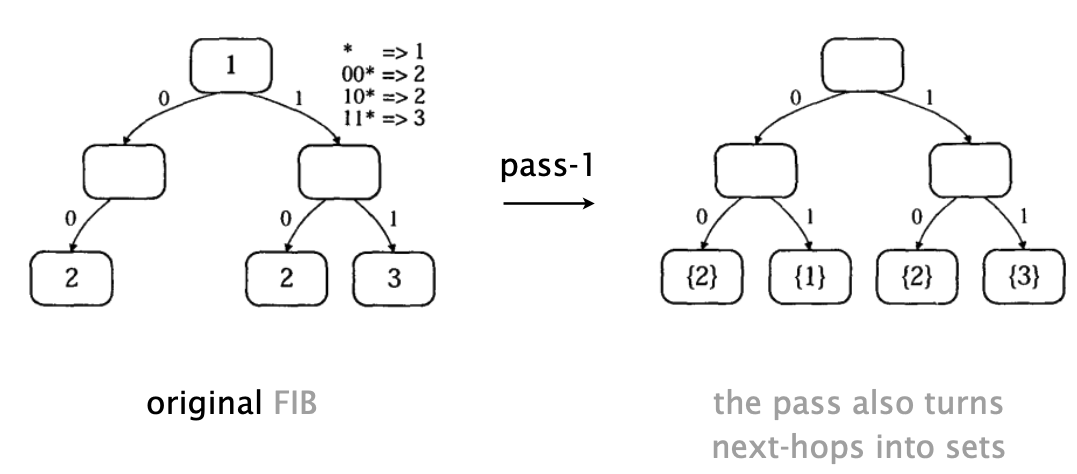 |
| 2. | next-hop ranking | post-order, from the leaves up |  |
| 3. | prefix filtering | pre-order, from the root down |  |
The first pass normalizes the tree by fully expanding it, ensuring each node has either $0$ or $2$ children.
The second pass calculates the most common next-hops from the bottom up, by merging them according to the following logic. Namely, return the common elements if any, otherwise return the union.
The third pass moves down the tree, selecting next-hops and eliminating redundant routes.
ORTC is optimal but comes with tradeoffs when it comes to updating the compressed FIB.
ORTC does not support update operations to the aggregated FIB. The aggregated FIB must be recomputed upon each update.
Net result
Even if the cost is linear in the number of entries, it can still take hundreds of ms to update a table.
The effectiveness of prefix aggregation varies on a per-router basis.
The aggregation effectiveness depends on:
- how prefixes are distributed over the next-hops
- The fewer neighbours a router has, the better aggregation it may achieve
- If all prefixes share the same next-hop, aggregation is maximised
- how “aggregatable” prefixes are.
Prefix aggregation does not come for free computationally and therefore time-wise, both at the beginning and whenever there is an update.
DRAGON
DRAGON is a distributed route-aggregation technique where routers “think globally, but act locally”.
The main result is that by comparing routes for different prefixes, a router can locally compute which routes it can filter and not export while preserving routing and forwarding decisions globally.
When a router filters q, it does not create any forwarding entry for q and does not export q to any neighbor. 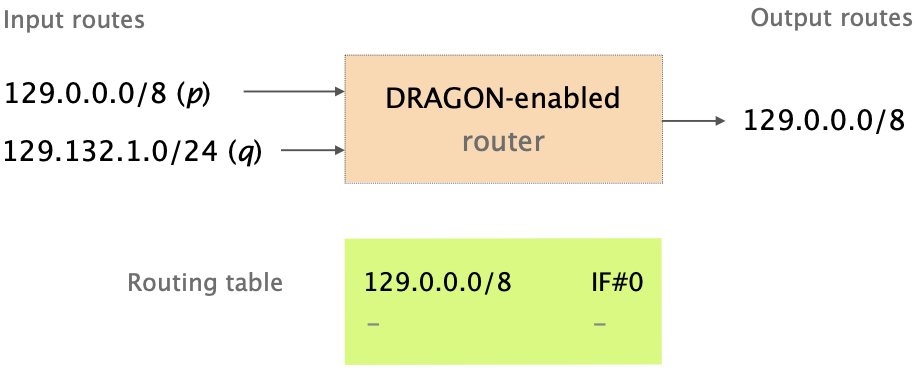
DRAGON routers propagate more-specific prefixes only in a small vicinity of their origins AS. Packets are forwarded according to increasingly more-specific prefixes as they reach the destination.
DRAGON guarantees network-wide routing and/or forwarding consistency post-filtering.
All PR nodes filtering is a Nash Equilibrium.
Any node has $2$ incentives to filter q-routes:
- retrieve a better route to forward traffic
- gain space in its routing and forwarding tables
with no node having a unilateral incentive to move away.
Simple route consistent algorithm
Considering a node $u$, a child prefix $q$, its parent prefix $p$,
Algorithm
If $u$ is not the destination for $q$ and If elected $q$-route $≥$ elected $p$-route then $u$ filters $q$-routes
DRAGON relies on isotonicity, a property which characterizes the combined policies of $2$ neighbors.
Isotonicity
If an AS $u$ prefers one route over another, a neighboring AS does not have the opposite preference.
It is required for optimality, not correctness.
DRAGON shows extremely good performance on inferred Internet topologies:
- Between 50% and 80% of the prefixes can be filtered on the vast majority of the nodes
- Convergence time can be reduced as much as $8$ times with $73\%$ of the prefixes seeing an improvement
- Good filtering efficiency is quickly reached: $90\%$ of ASes filter prefixes when $100$ ASes deploy DRAGON
DRAGON node can automatically introduce aggregation prefix to filter prefixes without parent.
- A node can autonomously announce aggregation prefixes based on local computation and preserving consistency.
- Routing system self-organizes itself in case of conflict when more than $1$ node announce the same parent prefix
- Number of aggregation prefixes introduced can be tuned
- e.g., maximum prefix length or minimum number of covered children


